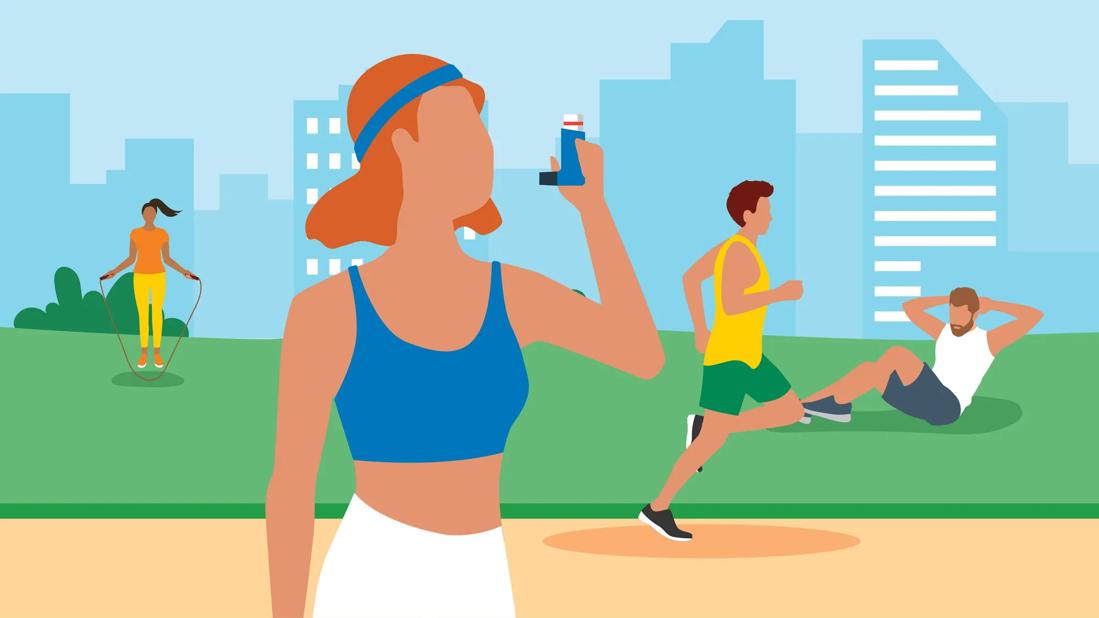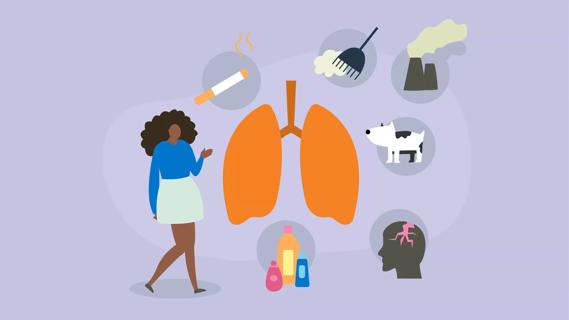Checking the weather, pollen counts and air quality can help you avoid asthma triggers

Exercising is one of the most important things that you can do for your health. But if you have asthma, getting that physical activity — especially in the great outdoors — can become complicated.
Advertisement
Cleveland Clinic is a non-profit academic medical center. Advertising on our site helps support our mission. We do not endorse non-Cleveland Clinic products or services. Policy
But the breathing condition doesn’t have to be a barrier to working out under the sun. It’s just an obstacle to overcome.
“Asthma shouldn’t hold you back,” says pulmonologist Neha Solanki, MD. “You should be able to work out and participate in any sport or activity you want, regardless of a diagnosis of asthma, as long as you’re working with your doctor and your asthma is optimized.”
Exercise helps breathing by building stamina and muscle strength, which:
“The more you exercise, the more you strengthen and improve the capacity of your lungs,” says Dr. Solanki. “You’re able to take larger breaths in, which means your body can get more oxygen. That puts you in a better position when it comes to dealing with your asthma.”
But while exercise may help protect against asthma, it can also trigger symptoms. That’s why it’s essential to have a plan in place to manage your asthma on a day-to-day basis and when you work out.
“If you’re going to successfully exercise with asthma, it’s best to approach it with an awareness of the condition and what it means for you,” she adds.
Advertisement
Exercise-induced asthma can happen during any physical activity, but it’s more likely to occur under certain conditions. Here’s what you do to limit your chances of breathing difficulties.
The dry air that comes with cold winter temperatures can set off an asthma attack. Ditto for hot, humid air that weighs heavy during the dog days of summer. High pollen counts can complicate breathing, too.
That’s why it’s important to check your local weather forecast before bolting through your front door for a workout.
“People have different triggers, which is what makes asthma challenging to treat,” says Dr. Solanki. “You have to know your body, know your lungs and how they’ll react to whatever is happening outside.”
If you know that certain situations cause you difficulties, take them into account and adjust. That may mean changing the time of your workout to the part of the day — morning or evening — where you’re least likely to encounter your triggers.
And wearing a face covering in cold weather, like a scarf or mask, can help keep your airways moist despite the dry air.
There’s more to air than what you might think. Microscopic irritants float all around us, contaminating the air you take in with each breath — and some days are far, far worse than others.
Excessive particulates in the air can trigger breathing-related conditions like asthma. That’s why it’s important to pay attention to air quality alerts. These tell you when the outside air reaches unhealthy levels, says Dr. Solanki.
Air quality can change quickly depending on a variety of factors, including traffic, wildfires and weather. (Keep track of your community in the United States by checking the U.S. Air Quality Index.)
“On days when the air quality isn’t good, you probably want to avoid exercising outdoors,” she suggests.
Avoiding asthma triggers may mean avoiding certain settings for your outdoor workout.
Running alongside a high-traffic roadway might not be your best option because of auto emissions that could irritate your airways, for instance. Ditto for a park path lined with pollen-producing blossoms.
“Look for areas where you’re least likely to experience problems,” advises Dr. Solanki.
Warming up before a workout is good advice for everyone to get your heart and lungs ready for what’s ahead — but it’s especially critical if you have asthma.
The reason? “If you have asthma, your airways are more sensitive and more reactive,” says Dr. Solanki. “So, it’s important to spend five or 10 minutes warming up so your lungs get used to having that increased airflow.”
Advertisement
Stop and give your lungs a break if you notice your asthma flaring up.
“It’s really important to not try to push through those times when you’re feeling chest discomfort or shortness of breath,” cautions Dr. Solanki. “Listen to your body and be aware of your situation. Don’t put your health at risk.”
If you have asthma, it’s a reality that can’t be ignored. That’s why it’s important to work with your healthcare provider to create an asthma management plan that allows you to pursue your fitness goals.
“It’s very important to use your inhaler and medication as prescribed and follow your plan,” emphasizes Dr. Solanki. “These are all tools to help you perform at your best.”
The plan may include using a quick-relief inhaler 10 to 15 minutes before an exercise session to prepare your airways for what’s ahead.
Keep an emergency inhaler handy during workouts in case your breathing becomes labored and your lungs need extra assistance. That means carrying the inhaler with you when you’re out on a long run, hike or bike ride.
“With asthma, your breathing is OK until it’s not OK — and that change can come quickly,” states Dr. Solanki. “You can’t predict when it might happen, so you want to be prepared.”
Advertisement
Bring a cell phone along, too, in case you need to call for help. Working out with a buddy also adds an extra layer of protection. “It’s important that you’re not alone without access to the outside world if you have an asthma attack,” she adds.
Don’t force an outdoor workout if the conditions aren’t right for you, urges Dr. Solanki. Knowing your triggers is key. Move your exercise indoors if:
“Be aware of your limitations and be willing to be flexible,” says Dr. Solanki. “On those days when it’s bad outside, find a way to move your workout inside.”
Advertisement
Learn more about our editorial process.
Advertisement

Adult-onset asthma has the same symptoms as childhood asthma, but tends to be more severe

An asthma action plan is a personalized, step-by-step set of instructions for handling asthma attacks

Stress can trigger and worsen asthma symptoms, like coughing and shortness of breath

Smoking, including secondhand smoke, can worsen your asthma triggers and damage your airways

Nighttime asthma attacks can be due to acid reflux, allergens and hormonal changes, but treatment can help prevent them

The effectiveness and safety of many of these options are unknown, so it’s best to stick to traditional care

Avoid triggers like dust, smoke and cold air to lessen your chances of coughing

Developmental changes like puberty and menopause can impact symptom severity

Start having sex about 72 hours before ovulation, then at least every other day during your fertile window

Attachment theory suggests that your earliest relationships shape connections throughout your life

It isn’t a recognized mental health disorder, but research shows that problematic social media use can negatively affect your mental health, self-esteem and sleep